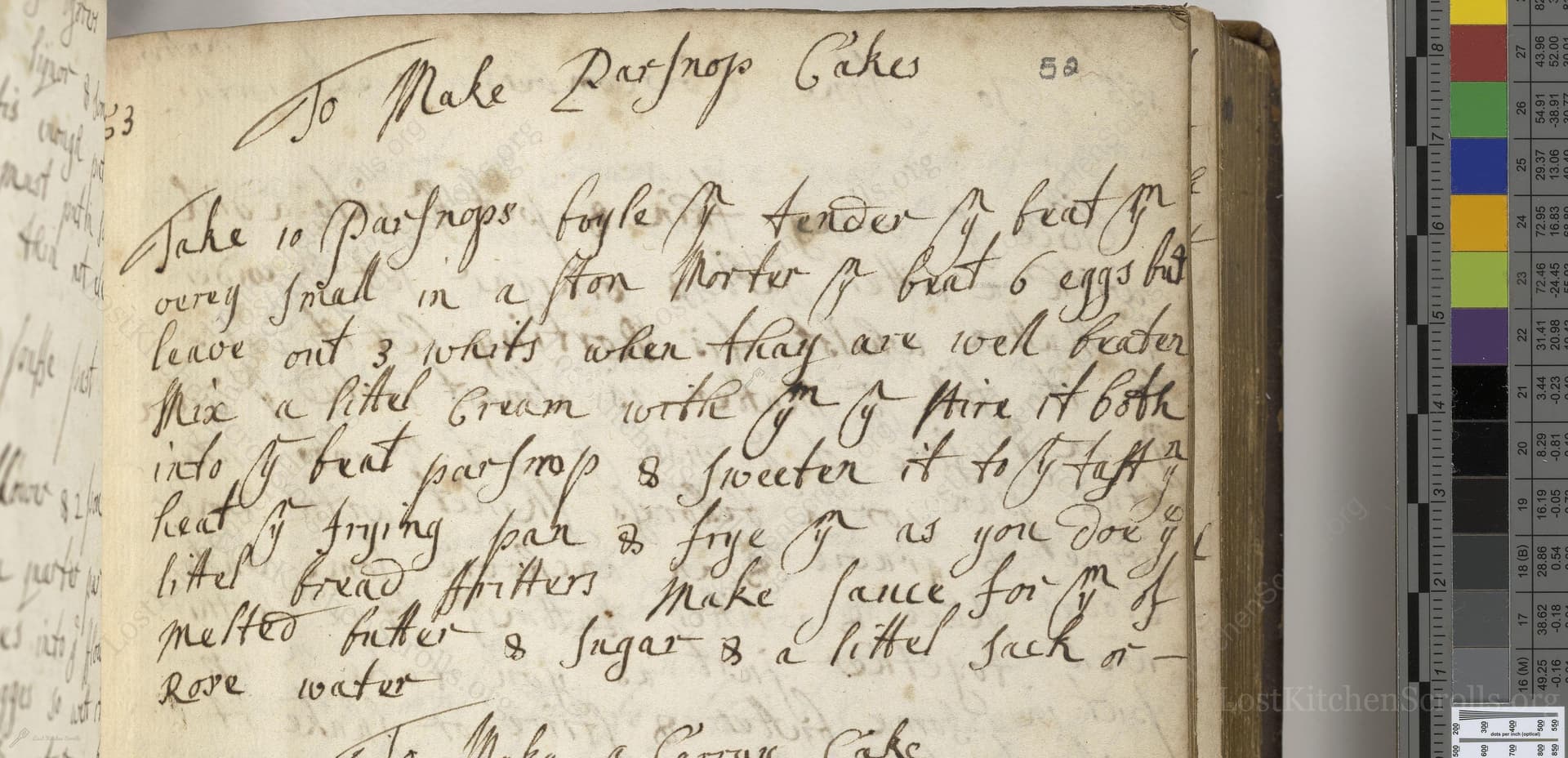To Make Parsnops Cakes
From the treasured pages of Receipt book
Unknown Author

To Make Parsnops Cakes
"Take 10 parsnops boyle ym tender & beat ym very small in a ston Morter & beat 6 eggs but leave out 3 whites when thay are well beaten mix a litle Cream with ym & pit it both into ye beat parsnop & sweeten it to tast heat ye frying pan & frye ym as you doe ye litle fried fritters Make sauce for ym of melted butterr & sugar & a litle Sack or rose water"
Note on the Original Text
The recipe features period English spelling, such as 'parsnops' for parsnips and 'ym' for 'them'. Ingredients and instructions are combined without precise measurements, relying on cooks' intuition and familiarity with textures and consistencies. The mixture of phonetic spelling and omission of explicit cooking times or temperatures is typical of early modern recipes, where experienced household cooks read between the lines. Instructions are brief — sometimes only a series of events or ingredients — with an expectation of considerable background knowledge.

Title
Receipt book (1700)
You can also click the book image above to peruse the original tome
Writer
Unknown
Era
1700
Publisher
Unknown
Background
Step back into the bustling kitchens of the 18th century, where this delightful collection offers a taste of bygone feasts, whimsical recipes, and the art of refined entertaining.
Kindly made available by
Folger Shakespeare Library
This recipe hails from the early 1700s, a period when root vegetables like parsnips were dietary staples, especially before the widespread adoption of potatoes in English kitchens. Sourced from an English handwritten recipe collection, it showcases both the resourcefulness and the sweet-savory palate of the Georgian era. Dishes like this were often served as elegant side items or even as part of a sweet course, demonstrating how vegetables were regularly used in both savory and sweet forms. The inclusion of Sack (a type of sherry) or rose water in the sauce is typical of upper-class English cuisine of the time, signaling both refinement and the international influences present in the period's foodways.

The original cook would have used a stone mortar and pestle to mash the parsnips, a whisk or fork to beat the eggs, and a heavy iron frying pan over an open flame or hearth for frying the cakes. Serving and sauce preparation would have involved a small saucepan or posnet for melting butter. Ladles, wooden spoons, and a slotted spoon or spatula for turning the cakes were common implements in such kitchens.
Prep Time
20 mins
Cook Time
20 mins
Servings
8
We've done our best to adapt this historical recipe for modern kitchens, but some details may still need refinement. We warmly welcome feedback from fellow cooks and culinary historians — your insights support the entire community!
Ingredients
- 1.5 lbs parsnips
- 6 large eggs (3 yolks only + 3 whole)
- 1/4 cup heavy cream
- 2-3 tbsp granulated sugar (to taste)
- 1 tbsp butter (for frying)
- 3 1/2 tbsp unsalted butter (for sauce)
- 2 tbsp sugar (for sauce)
- 2 tsp sherry (substitute: sweet white wine; or use 1 tsp rose water)
Instructions
- Begin by peeling and slicing about 1.5 pounds of parsnips.
- Boil them in water until they are very tender, then drain thoroughly.
- Mash the parsnips to a smooth purée using a food processor or potato masher (originally done in a stone mortar).
- In a bowl, whisk 6 eggs, omitting the whites from 3 of them (so, use 6 yolks and 3 whites).
- Add 1/4 cup of heavy cream to the eggs, then mix this with the mashed parsnip until smooth.
- Sweeten to taste with around 2-3 tablespoons of sugar.
- Heat a non-stick frying pan with a tablespoon of butter over medium heat.
- Drop spoonfuls of the batter into the pan to form small cakes, and fry until golden on both sides (about 2-3 minutes per side).
- For the sauce, melt 3 1/2 tablespoons of butter and stir in 2 tablespoons of sugar and a splash (about 2 teaspoons) of sherry (or use rose water for a floral note, about 1 teaspoon).
- Pour the warm sauce over the cakes before serving.
Estimated Calories
130 per serving
Cooking Estimates
Preparing the parsnips and mixing the batter takes about 20 minutes. Cooking each batch of cakes takes around 20 minutes. Each cake with sauce has about 130 calories. The recipe makes about 8 servings.
As noted above, we have made our best effort to translate and adapt this historical recipe for modern kitchens, taking into account ingredients nowadays, cooking techniques, measurements, and so on. However, historical recipes often contain assumptions that require interpretation.
We'd love for anyone to help improve these adaptations. Community contributions are highly welcome. If you have suggestions, corrections, or cooking tips based on your experience with this recipe, please share them below.
Join the Discussion
Rate This Recipe
Dietary Preference
Main Ingredients
Occasions

Den Bockfisch In Einer Fleisch Suppen Zu Kochen
This recipe hails from a German manuscript cookbook compiled in 1696, a time whe...

Die Grieß Nudlen Zumachen
This recipe comes from a rather mysterious manuscript cookbook, penned anonymous...

Ein Boudain
This recipe comes from an anonymous German-language manuscript cookbook from 169...

Ein Gesaltzen Citroni
This recipe, dating from 1696, comes from an extensive anonymous German cookbook...
Browse our complete collection of time-honored recipes



